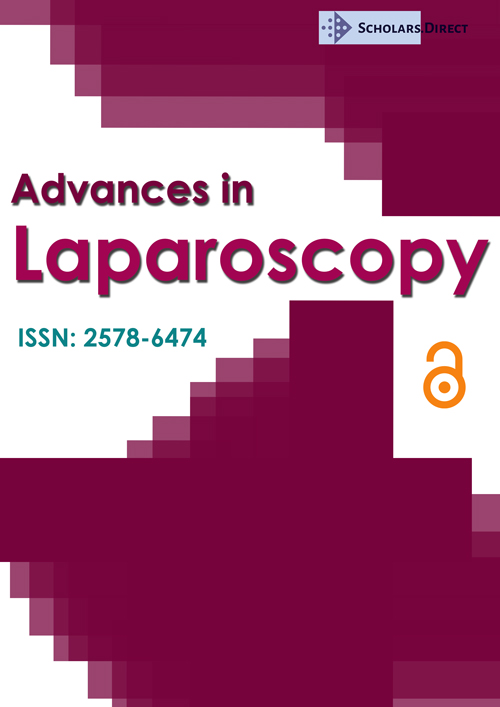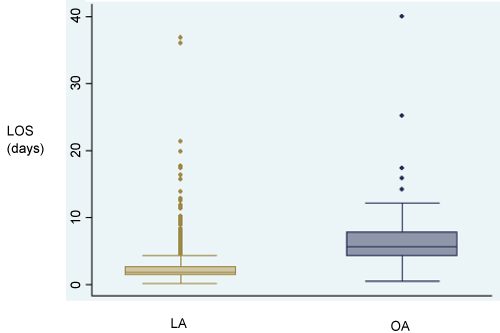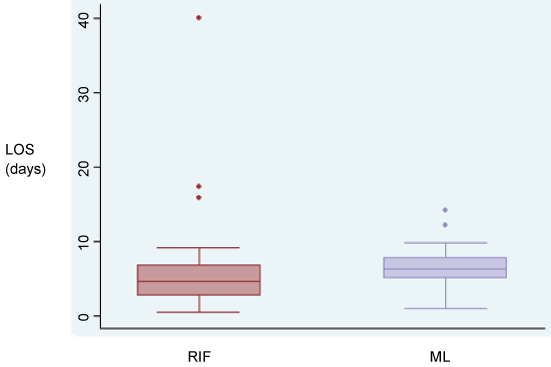Risk Factors and Consequences of Conversion in Laparoscopic Appendectomy
Abstract
Introduction
No studies in Australia have explored risk factors for Laparoscopic (LA) to Open Appendectomy (OA) conversion. Differences in outcome following a Midline (ML) or Right Iliac Fossa (RIF) approach for conversion have not been documented. The primary objective was to identify patient and surgical factors that increase the likelihood of conversion; secondary objective was to explore outcome differences between ML and RIF approach for conversion.
Methods
All patients who underwent LA at an Australian Metropolitan Hospital between 2011 and 2014 were retrospectively reviewed. Conversion rates were analyzed and outcome differences between a ML versus RIF approach for conversion were compared.
Results
There were 1316 initial LA and 67 were converted (OA 5.09%). Logistic regression showed that patients over 65 years were more likely to be converted (Odds ratio, (OR) 1.94, 95% confidence interval, (CI), 1.07-3.50; p = 0.029). American Society of Anesthesiologists (ASA) grade III-IV was another risk factor (OR 1.59, 95% CI, 1.06-2.37; p = 0.024). Conversions were associated with higher incidence of post-operative complications (p = 0.001) and a Longer Length of Stay (LOS): median difference 3.71 days; 95% CI, 3.20-4.14; p = 0.001. A ML approach for conversion increased the LOS (median difference 1.56 days; 95% CI, 0.27-2.91; p = 0.020).
Conclusions
Older patients and ASA grade III-IV were more likely to result in conversion. Conversions carried a higher risk of post-operative complications and longer LOS. A ML conversion was a contributing factor for increased LOS.
Keywords
Appendicitis, Laparoscopy, Risk, Post-operative complications, Length of stay, Conversion
Highlights
• Converting laparoscopic to open appendectomy increased the risk of complications
• Older patients and ASA grade III-IV were risk factors for conversion
• Midline incision approach for conversion contributed to increased length of stay
Introduction
Appendectomy for acute appendicitis is one of the most common surgical emergencies. Recent multicenter observational studies of performance variation in emergency appendectomy revealed extremely wide variation in practice patterns and outcomes among hospitals [1,2]. The preferred surgical management is an initial Laparoscopic Approach (LA) [1-3]. The principal advantages of this approach are a more precise diagnosis of appendicitis, reduction in post-operative pain, fewer superficial-surgical-site infection and earlier return to normal activity [3-5]. The principal disadvantages are an increased operating time, theatre cost and the potential risk of visceral injury in patients who had previous abdominal surgery.
The decision to convert a LA to an OA may be complex involving patient and surgical factors and ultimately it is indicated when the surgeon judges that the intended laparoscopic approach cannot be continued without risk.
There are no studies from Australia that have explored risk factors for LA to OA conversion. Furthermore, following a decision to convert, evidence-based guidelines are lacking whether a Midline (ML) incision conversion or a Right Iliac Fossa (RIF) approach should be preferred.
The primary objective of this study was to identify patient and surgical factors that increase the likelihood of conversion; a secondary objective was to explore differences in outcome between ML and RIF approach for conversion.
Methods
Study design and patients
A retrospective review was conducted of all 1316 patients who underwent LA between November 2011 and July 2014. Ethics approval was obtained from the Western Health Human Research Ethics Committee prior to the commencement of this study. The procedures were carried out at the two major campuses of Western Health, a large Metropolitan Health Network in Melbourne, Australia.
Data collection
De-identified information was collected from electronic medical records and included patient demographics, American Society of Anesthesiologist (ASA) score, prior abdominal surgery, operative details, Length of Stay (LOS), post-operative complications, as well as the level of training of the primary surgeon.
Selection of factors for analysis
Age (years) was categorized into three subgroups: paediatrics (9-18), adults (19-65) and elderly (> 65). Our Hospital is accredited to manage children from 9 years and above. Surgeon status was divided into two subgroups consisting of consultants and trainees (fellows and registrars). ASA score was used as a representation of the overall health of the patient's fitness for surgery. Patient gender and history of previous abdominal surgery were also included. Other factors that have generated conflicting results for conversion in the published literature were not used [6,7].
Outcome measures
The primary outcome measure was the conversion rate from LA to OA in relation to patients' demographics and surgical factors; secondary outcome measures were the operative duration, post-operative complications and LOS between a Midline (ML) versus a Right Iliac Fossa (RIF) approach for the converted (OA) group.
Statistical analysis
Descriptive statistics were presented as median and Inter-Quartile Range (IQR). Categorical data (un-ordered or singly-ordered) were analysed using non-parametric exact unconditional test for differences of proportions [8]. Continuous variables were compared using exact permutation Wilcoxon-Mann-Whitney test [9].
Univariate analysis was followed by binary logistic regression modelling to evaluate the independent association of patient and surgeon factors with conversion to OA. Sample size considerations satisfied the assumption of at least 10 events (conversion rate) per variable for logistic modelling [10]. As the event rate (conversion) was less than 10%, Odds Ratio (OR) was the appropriate metric to represent risk [11].
The presence of missing ASA data (204 of 1316; 15% and 14% in the LA and OA groups respectively) were treated as missing at random and multiple imputation using 20 imputation sets were used to calculate adjusted ORs in regression modelling [12].
Statistical significance was declared at α = 0.05 (two-sided). Analyses were conducted with StatXact (StatXact version 9.00, Cytel Inc, Cambridge, MA, USA) and Stata 12 (StataCorp, College Station, TX, USA).
Results
There were 1316 patients identified who underwent an initial laparoscopic approach for acute appendicitis. The age range was from 9 to 90 years (median 28, Inter-Quartile Range (IQR) 19-41). The Female (F) to Male (M) ratio was 586:730. The histological negative appendectomy rate was 8.66% (114 of 1316), all of which were completed by LA.
LA to OA conversion
Univariate analysis
Of the 1316 initial LA, 67 cases were converted to OA (5.09%). Table 1 displays the patient demographics, outcomes and univariate analysis of patient and surgical factors for conversion and Table 2 shows the intra-operative reasons recorded by the primary surgeon for conversion and assessment of the severity of appendicitis based on the published Sunshine Appendicitis Grading System Score (SAGS score) [13]. Age and ASA grade were significant factors for conversion whereas primary surgeon status, gender and history of previous abdominal surgery were not. Conversions to OA were associated with significantly higher incidence of post-operative complications and a longer LOS: median difference 3.71 days; 95% CI, 3.20-4.14 (Figure 1).
Logistic regression analysis
Table 3 displays the adjusted Odds Ratio (OR) from logistic regression modelling using conversion as the outcome variable. Patients over 65 years had nearly twice the risk of conversion to OA (OR 1.94, 95% CI, 1.07-3.50). In addition, grade III-IV ASA (OR 1.59) and consultants as primary surgeon (OR 1.34) were significant factors for conversion in the regression model.
Midline Incision (ML) versus Right Iliac Fossa (RIF) approach for OA
Patient characteristics and outcome data for the 67 converted cases sub-grouped into RIF or ML incision are shown in Table 4 and Table 5 shows their frequencies of post-operative complications (Dindo-Clavien classification [14]) by type of incision. There were 27 RIF and 40 ML incisions for conversion with a significant older age group receiving a ML incision for OA. Duration of operation was not different between the groups but a ML approach for OA increased the LOS: median difference 1.56 days; 95% CI, 0.27-2.91 (Figure 2). Thirty-days' post-operative complication incidence by type of incision was not significantly different.
Discussion
In this study of 1316 patients with acute appendicitis, the majority (94.91%) was managed successfully and safely by a Laparoscopic Approach (LA). There were 67 conversions from LA to OA, a conversion rate of 5.09%. That is well below the 10% rate in a meta-analysis report of 54 randomized trials, even though many of the reported studies are now dated due to advancements in laparoscopic techniques since [15]. The intra-operative reasons for conversion as recorded by the primary surgeon are listed in Table 2. Purulent appendicitis with free pus and perforated appendicitis made up 25% of the reasons for conversion (SAGS score 3 and 4) [13]. The technical factors recorded were judgemental and lends support to the view that the decision to convert to OA is complex involving multiple factors but ultimately when the surgeon judges that the intended laparoscopic approach cannot be continued without risk [6,16].
Two risk factors for conversion to OA were identified on univariate analysis (Table 1). Age greater than 65 years and ASA grade III-IV were significant factors which were in agreement with previous studies on this topic [6,16]. On univariate analysis, with no adjustments for other covariates, there was no difference between consultants and trainees' conversion rates.
Logistic regression modelling (Table 3) with adjustments for other covariates (gender and history of previous abdominal surgery) confirmed age greater than 65 years had nearly twice the risk of conversion to OA (OR 1.94, 95% CI, 1.07-3.50). ASA grade III - IV was also a risk factor for OA conversion (OR 1.59, 95% CI, 1.06-2.37). By regression modelling, consultants as primary operators were more likely to decide to convert (OR 1.34, 95% CI, 1.02-1.76). In the situation when a consultant was called into the operating room to assist a trainee (due to one or more of the intra-operative factors listed in Table 2), the operative record would have indicated that the consultant was the primary operator.
There was a significant difference in post-operative complication rates between the LA and OA groups (Table1), 4.64% versus 22.39% respectively, P = 0.001, accompanied by an increased LOS (Figure 1) in the OA group (median difference 3.71 days, 95% CI, 3.20-4.14).
Sub-group analysis of the 67 patients converted to OA (Table 4) showed that there were more ML incisions (40 versus 27) made in the older age patients. The choice of a ML as distinct from a RIF approach for conversion by the surgeon remained unclear but there is little reason to doubt the clinical observation that many younger trainees and surgeons are unfamiliar with performing an RIF incision since the advent of LA.
It could be argued that with the benefit of an initial laparoscopic survey, localization of the area of inflammation should enable planning of an optimal incision for conversion. In this series, a ML approach for conversion increased the LOS (Figure 2): median difference 1.56 days; 95% CI, 0.27-2.91; P = 0.020) further contributing to extended LOS in the converted group. The argument for ML laparotomy to enable peritoneal washout in purulent appendicitis with four quadrant contamination is not supported by a recent randomized trial of safe and effective laparoscopic lavage for perforated diverticulitis with purulent peritonitis [17]. Excessive use of a ML approach for OA not only has the potential of prolonging LOS but the increased risk of development of incisional hernias. Comparison of the frequencies of post-operative complications between ML and RIF conversions showed no difference; this was likely due to inadequate sample size and power for the subgroups in this retrospective study and a short follow-up period.
This study had a high-volume caseload. In that it is retrospective in nature and in a single institution, the extent to which the findings in this study can be applied to other settings is uncertain. A randomized control study on a ML versus RIF approach following a decision to convert should help to generate the required evidence-based guidelines for future practice.
Conclusions
Older patients and ASA grade III-IV were more likely to result in conversion to OA. Conversions carried a higher incidence of post-operative complications and longer LOS. Following a decision to convert, more considerations should be given in planning the approach. A ML incision for conversion was a contributing factor for increased LOS and has the potential for future incisional hernias.
Acknowledgements
None.
Disclosure Statement
This research did not receive any specific grant from funding agencies in the public, commercial, or not-for-profit sectors.
References
- National Surgical Research Collaborative (2013) Multicentre observational study of performance variation in provision and outcome of emergency appendicectomy. Br J Surg 100: 1240-1252.
- Bulian DR, Knuth J, Sauerwald A, et al. (2013) Appendectomy in Germany - an analysis of a nationwide survey 2011/2012. Int J Colorectal Dis 28: 127-138.
- van Rossem CC, Bolmers MD, Schreinemacher MH, et al. (2016) Prospective nationwide outcome audit of surgery for suspected acute appendicitis. Br J Surg 103: 144-151.
- Moberg AC, Berndsen F, Palmquist I, et al. (2005) Randomized clinical trial of laparoscopic versus open appendicectomy for confirmed appendicitis. Br J Surg 92: 298-304.
- Kouhia ST, Heiskanen JT, Huttunen R, et al. (2010) Long-term follow-up of a randomized clinical trial of open versus laparoscopic appendicectomy. Br J Surg 97: 1395-1400.
- Wagner PL, Eachempati SR, Aronova A, et al. (2011) Contemporary predictors of conversion from laparoscopic to open appendectomy. Surg Infect 12: 261-266.
- Antonacci N, Ricci C, Taffurelli G, et al. (2015) Laparoscopic appendectomy: Which factors are predictors of conversion? A high-volume prospective cohort study. Int J Surg 21: 103-107.
- Ludbrook J, (2011) Is there still a place for Pearson's chi-squared test and Fisher's exact test in surgical research? ANZ J Surg 81: 923-926.
- Bergmann R, Ludbrook J, Spooren WP (2000) Different outcomes of the Wilcoxon-Mann-Whitney test from different statistics packages. Am Stat 54: 72-77.
- Peduzzi P, Concato J, Kemper E, et al. (1996) A simulation study of the number of events per variable in logistic regression analysis. J Clin Epidemiol 49: 1373-1379.
- Altman DG, Deeks JJ, Sackett DI (1998) Odds ratios should be avoided when events are common. BMJ 317: 1318.
- White IR, Royston P, Wood AM (2011) Multiple imputation using chained equations: issues and guidance for practice. Stat Med 30: 377-399.
- Reid F, Choi J, Williams M, et al. (2017) Prospective evaluation of the Sunshine Appendicitis Grading System score. ANZ J Surg 87: 368-371.
- Dindo D, Demartines N, Clavien PA (2004) Classification of surgical complications: a new proposal with evaluation in a cohort of 6336 patients and results of a survey. Ann Surg 240: 205-213.
- Sauerland S, Jaschinski T, Neugebauer EA (2010) Laparoscopic versus open surgery for suspected appendicitis. Cochrane Database Syst Rev 4:CD001546.
- Liu SI, Siewert B, Raptopoulos V, et al. (2002) Factors associated with conversion to laparotomy in patients undergoing laparoscopic appendectomy. J Am Coll Surg 194: 298-305.
- Angenete E, Thornell A, Burcharth J, et al. (2016) Laparoscopic lavage is feasible and safe for the treatment of perforated diverticulitis with purulent peritonitis. Ann Surg 263: 117-122.
Corresponding Author
Steven TF Chan, Melbourne Medical School-Western Precinct, Sunshine Hospital, The University of Melbourne, Furlong Road, VIC 3021, Australia, Tel: 61383958116.
Copyright
© 2017 Bui HT, et al. This is an open-access article distributed under the terms of the Creative Commons Attribution License, which permits unrestricted use, distribution, and reproduction in any medium, provided the original author and source are credited.






